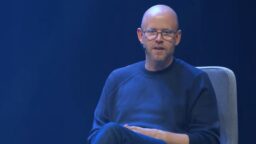
The MBW Review offers our take on some of the music biz’s biggest recent goings-on. This time, we scrutinize Daniel Ek‘s presentation at Spotify‘s Investor Day earlier this month. The MBW Review is supported by FUGA.
Daniel Ek wants Spotify to flatten the ‘gatekeepers’ of the traditional music business.
In doing so, he says, the platform will grossly improve the amount of money that a great swathe of artists are making from their craft.
Ek offered some revolutionary patter at Spotify’s Investor Day in New York earlier this month, where he boldly informed his audience that his service “doesn’t believe in gatekeepers” – before laying down a thrilling, scene-stealing proclamation: “Our mission is to enable one million artists to live off their work.”
This sounds absolutely brilliant, of course.
Especially when you consider what’s been said many times about those dastardly music biz ‘gatekeepers’ – that they have constructed such an elaborate maze of an industry, only the exclusive ‘one percent’ can ever hope to make the big bucks.
The ‘one percent’. Remember that phrase.
In truth, Daniel Ek is setting his company a momentous challenge – one which, frankly, looks frighteningly difficult when you consider the hard data available today.
Ek proudly told analysts at the Investor Day that, at the end of 2017, Spotify counted 22,000 artists within what he terms the “top tier” of earners on the platform.
This, said Ek, represented a 28% rise on the 16,000 artists who were in Spotify’s “top tier” just two years previously.

Then, another statty proclamation heralding a future digital music utopia.
“My goal over the next few years is to increase that number of [‘top tier’] creators to hundreds of thousands that have material success on our platform,” said Ek.
Here comes some very basic, but highly relevant, mathematics.
According to Ek, Spotify currently has three million artists on its platform.
The 22,000 ‘top-tier’ acts which he referenced make up precisely 0.733% of this figure.
Which is interesting. Because… you’re already there, right?
That’s not ‘the one percent’, is it?
That’s less than ‘the one percent’.
It’s a shame none of the Wall Street analysts in attendance at Spotify’s Investor Day thought to query that ‘28% growth in top tier artists’ slide above.
Because this is what it looks like in more meaningful terms.


It’s important to mention at this juncture that Daniel Ek never exactly confirmed what kind of monetary recompense the “top tier” of Spotify artists are currently receiving.
He did, however, provide a helpful clue: he referenced the fact these acts are enjoying “material success”, while nodding to his long-term dream of a million-plus Spotify artists being able to “live off their work”.
This language triggered a memory in my head.
Back in summer 2015, I witnessed an impressive presentation at an industry conference tied to the Way Out West festival in Gothenburg, given by Ola Sars.
Sars is the CEO of Soundtrack Your Brand – a startup co-owned by Spotify which aims to make gaining a public licence for the streaming platform easier for consumer-facing companies.
As part of his pitch, Sars – also one of the original founders of Beats Music – noted how Soundtrack Your Brand could offer a new revenue opportunity for a host of artists on Spotify.
And then, to drive home why that was so important, he revealed some surprising numbers.


The figures from Sars’ presentation above are very relevant to the Spotify ‘top tier’ discussion of today.
They are based, as noted, on two reports: (i) the IFPI‘s 2014 annual review of the global recorded music industry; and (ii) an in-depth essay covering how global streaming royalties get divided from the University Of Oslo, written in 2013.
Using these two sources, Sars showed an estimate of the revenue split between what was then assumed to be the total number of revenue-generating recording artists in the world: 200,000.
As you can see, these figures suggest that just the world’s biggest 10 artists took home 7.6% of all streaming revenues ($1.6bn) that year.
The next 90 biggest artists took a further 24.2% share, while the next 400 after that grabbed 26.5% of the money.
Or to put it another way: the top 0.25% of artists took home 58.3% of all streaming money in 2014.
Ready for an even bigger stat?
The top 2.5% of global artists took home nearly 90% of streaming revenues in 2014.

I believe Daniel Ek when he says that he wants Spotify to become the centrifugal force in a more democratised recorded music industry; to build, as he puts it, “an ecosystem to support artists that’s accessible, that’s transparent and that’s democratic… that’s about promoting opportunity rather than picking winners and losers”.
It would also be incorrect to suggest that amongst all his talk of knocking down industry ‘gatekeepers’, Ek actually wants rid of the record label structure entirely.
He made specific mention in his Investor Day speech that, as Spotify drives streaming artist discovery worldwide, the “need to nurture great talent is larger than ever before”
He added: “We believe that great music and artists in the future will come from specialised talent incubators like the labels of the past – [which] brings opportunities for the next Berry Gordy, Rick Rubin or Ahmet Ertegun.”
Yet it was also clear that Ek believes labels are gradually being forced to relinquish their ‘gatekeeper’ responsibilities.
He noted that over 30% of consumption on Spotify is now a direct result of recommendations made by the platform’s own algorithms and curation teams – something he said “puts Spotify in control of the demand curve”.
(Side note: isn’t a pretty robust definition of a ‘gatekeeper’… one who “controls” demand?)
At one point in his speech, Ek proclaimed that Spotify is aiming to more than treble the number of artists on its platform – from 3m today to 10m in the next few years.
He said that this would mean “more great artists” would find success on Spotify “if only people can find them”. And he predicted that Spotify’s software could do this job more efficiently and fairly than any industry structure from the past.
It’s certainly true that, even with a 0.73% subset of ‘top tier’ artists, a 10m total base would see 73,000 people earning big money on Spotify – and that’s a significant volume of acts.
But wouldn’t these figures also leave 9.99m-plus artists failing – in Ek’s own words – to gain “material success” on the platform?
Boasting of Spotify’s growing batch of ‘top tier’ artists, Ek said at the Investor Day: “This is not like a streaming video service where only a few thousand items of content matter.
“On Spotify, there will be more creators – and the number of creators that matter will also increase.”
Spotify needs to be extremely wary of focusing too hard on the sub-one-percent of “creators that matter”.
Otherwise, it risks leaving millions upon millions of their peers feeling left out in the cold.





